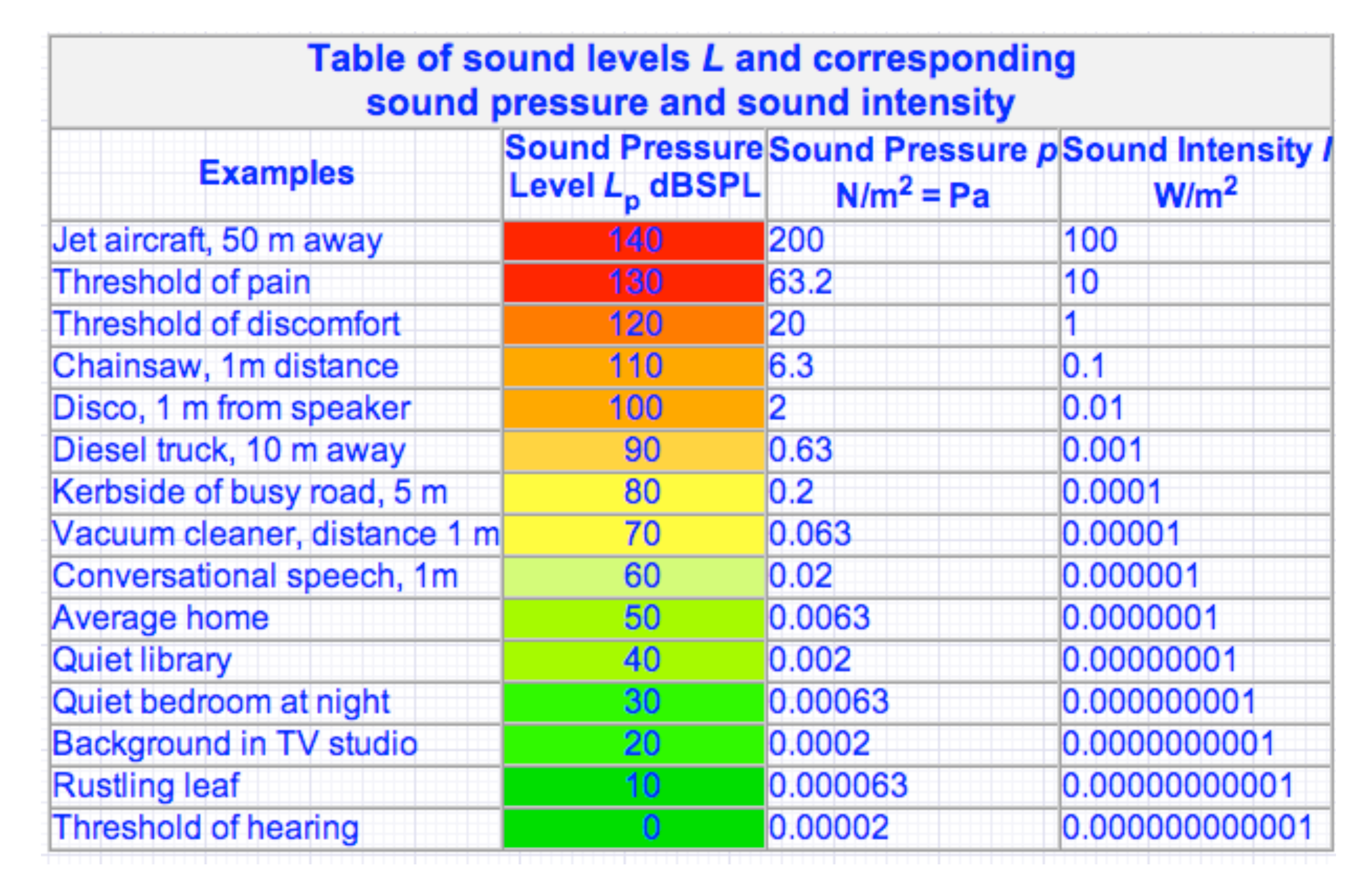The Sound¶
The sound waves¶
- A wave is an oscillation of energy propagating in a physical medium.
- Sound waves are sound mechanical waves of pressure that transmit energy through the collision of particles (see this).
- Sound waves are longitudinal waves (the direction of the oscillation coincides with the direction of the propagation), and the velocity of propagation is proportional to the elasticity (or ease of deformation) of the medium.
| Media | Speed |
|---|---|
| Air (0$^o$ C) | 331 m/s |
| Air (20$^o$ C) | 334 m/s |
| Oxygen (0$^o$ C) | 316 m/s |
| Hydrogen (0$^o$ C) | 1.284 m/s |
| Lead (20$^o$ C) | 1.230 m/s |
| Watter (15$^o$ C) | 1.450 m/s |
| Iron (20$^o$ C) | 5.130 m/s |
| Granite | 6.000 m/s |

Temporal representation of sound¶
- Sound waves can be represented by measuring the particles displacement from its equilibrium over time using a graph such as:

Frequency representation of sound¶
- Because the periodic nature of the sound waves, we can also represent the basis of the frequency components (pure sinusoidal signals), that compose them. This is done using Fourier analysis. The result is a graph of the type:

Musical notes are produced by vibrating elements to certain frequencies. By definition, the spectrum of a musical note accumulates most of its energy (different from zero) in the frequencies:
$$ \omega_0, 2\omega_0, 3\omega_0, \cdots $$
where $\omega_0$ is the fundamental frequency of the note (which indicates which note is) and $2\omega_0, 3\omega_0, \cdots$ is the pitch of the note (which amplitudes depend on the musical instrument that has produced the notes).
A classification of the sound waves¶
- Depending of the compositing frecuencies, se talk about:
- Infrasounds: those sounds with a frequency smaller than $20$ Hz (not perceptible by humans).
- Audible sounds: between $20$ and $20{.}000$ Hz.
- Ultrasounds: over $20{.}000$ Hz. Also unnoticeable.
- These frequency ranges vary between individuals. These values are average values.
Intensity of sound waves¶
- Sound intensity depends on the amplitude of the particle oscillations, which cause pressure variations in the eardrum}. This way we perceive sound.
- The most common way to express a sound intensity $I$ is relatively respect to the intensity needed to reach the threshold of hearing, which by definition is $20\mu~\text {P}$ of pressure ($1$ Pascal = $1$ Newton/m$^2$). In this case, the relative loudness or relative SPL (Sound Pressure Level) is expressed as: $$ \text{SPL} = \frac{I}{20\mu~\text{Pa}} $$
- The human auditory system reacts logarithmically to sound intensity. Therefore, we generally express this physical measure in decibels (dB). In this case: $$ \text{SPL}[\text{dB}] = 20\log\frac{I}{20\mu~\text{Pa}} $$
- The following table shows some examples with typical sound intensities expressed in dB's. Also it has been added a column to have an idea of the absolute measure of the real intensity $I$.
| Context | $\text{SPL}[\text{dB}]$ | Intensity of sound $I$ |
|---|---|---|
| Auditory threshold | $0$ dB | $20\mu~\text{Pa}$ |
| Whisper | $20$ dB | $10\times 20\mu~\text{Pa}$ |
| Conversation | $40$ dB | $100\times 20\mu~\text{Pa}$ |
| Traffic | $60$ dB | $1{.}000\times 20\mu~\text{Pa}$ |
| Subway | $80$ dB | $10{.}000\times 20\mu~\text{Pa}$ |
| Threshold of Pain | $140$ dB | $10^{7}\times 20\mu~\text{Pa}$ |
| Jet Engine | $160$ dB | $10^{8}\times 20\mu~\text{Pa}$ |
- The human ear is able to work properly between $20\mu~\text{Pa}$ ($0$ dB) and $100\mu~\text{Pa}$ ($114$ dB), approximately.